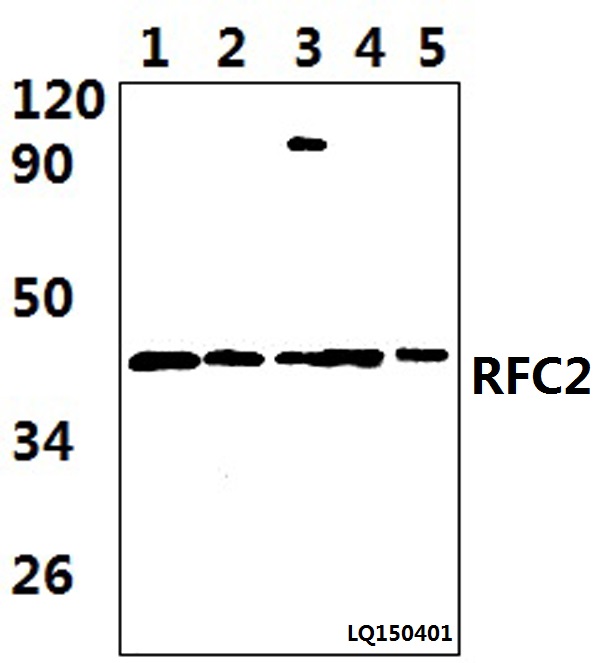Product Name :
RFC2 (T165) polyclonal antibody Background :
Replication factor C (RFC) is an essential DNA polymerase accessory protein that is required for numerous aspects of DNA metabolism, including DNA replication, DNA repair and telomere metabolism. RFC is a heteropentameric complex that recognizes a primer on a template DNA, binds to a primer terminus and loads proliferating cell nuclear antigen (PCNA) onto DNA at primer-template junctions in an ATP-dependent reaction. All five of the RFC subunits share a set of related sequences (RFC boxes) that include nucleotidebinding consensus sequences. Four of the five RFC genes (RFC1, RFC2, RFC3 and RFC4) have consensus ATP-binding motifs. The small RFC proteins, RFC2, RFC3, RFC4 and RFC5, interact with Rad24, whereas the RFC1 subunit does not. RFC2, the third-largest subunit of the RFC complex, exhibits ATP binding which makes it important for both DNA replication and checkpoint function. Product :
Rabbit IgG, 1mg/ml in PBS with 0.02% sodium azide, 50% glycerol, pH7.2 Storage&Stability :
Store at 4°C short term. Aliquot and store at -20°C long term. Avoid freeze-thaw cycles. Specificity :
RFC2 (T165) polyclonal antibody detects endogenous levels of RFC2 protein. Immunogen :
Synthetic peptide, corresponding to amino acids 150-200 of Human RFC2. Conjugate :
Unconjugated Modification :
Unmodification
RFC2 (T165) polyclonal antibody Background :
Replication factor C (RFC) is an essential DNA polymerase accessory protein that is required for numerous aspects of DNA metabolism, including DNA replication, DNA repair and telomere metabolism. RFC is a heteropentameric complex that recognizes a primer on a template DNA, binds to a primer terminus and loads proliferating cell nuclear antigen (PCNA) onto DNA at primer-template junctions in an ATP-dependent reaction. All five of the RFC subunits share a set of related sequences (RFC boxes) that include nucleotidebinding consensus sequences. Four of the five RFC genes (RFC1, RFC2, RFC3 and RFC4) have consensus ATP-binding motifs. The small RFC proteins, RFC2, RFC3, RFC4 and RFC5, interact with Rad24, whereas the RFC1 subunit does not. RFC2, the third-largest subunit of the RFC complex, exhibits ATP binding which makes it important for both DNA replication and checkpoint function. Product :
Rabbit IgG, 1mg/ml in PBS with 0.02% sodium azide, 50% glycerol, pH7.2 Storage&Stability :
Store at 4°C short term. Aliquot and store at -20°C long term. Avoid freeze-thaw cycles. Specificity :
RFC2 (T165) polyclonal antibody detects endogenous levels of RFC2 protein. Immunogen :
Synthetic peptide, corresponding to amino acids 150-200 of Human RFC2. Conjugate :
Unconjugated Modification :
Unmodification
-
 Western blot (WB) analysis of RFC2 (T165) polyclonal antibody at 1:1000 dilution Lane1:MCF-7 whole cell lysate(48ug) Lane2:The Intestines tissue lysate of Rat(25ug) Lane3:The Intestines tissue lysate of Mouse(35ug) Lane4:The Lung tissue lysate of Rat(39ug) Lane5:The Lung tissue lysate of Mouse(38ug)
Western blot (WB) analysis of RFC2 (T165) polyclonal antibody at 1:1000 dilution Lane1:MCF-7 whole cell lysate(48ug) Lane2:The Intestines tissue lysate of Rat(25ug) Lane3:The Intestines tissue lysate of Mouse(35ug) Lane4:The Lung tissue lysate of Rat(39ug) Lane5:The Lung tissue lysate of Mouse(38ug)
Bioworld Biotech only provide peptides for our antibodies and do not provide additional peptide customization services.
Price/Size :
USD 368/1mg/vial
Tips:
For phospho antibody, we provide phospho peptide(0.5mg) and non-phospho peptide(0.5mg).Describe :
Blocking peptides are peptides that bind specifically to the target antibody and block antibody binding. These peptide usually contains the epitope recognized by the antibody. Antibodies bound to the blocking peptide no longer bind to the epitope on the target protein. This mechanism is useful when non-specific binding is an issue, for example, in Western blotting (WB) and Immunohistochemistry (IHC). By comparing the staining from the blocked antibody versus the antibody alone, one can see which staining is specific; Specific binding will be absent from the western blot or IHC performed with the neutralized antibody.Formula:
Synthetic peptide was lyophilized with 100% acetonitrile and is supplied as a powder. Reconstitute with 0.1 ml DI water for a final concentration of 10 mg/ml.The purity is >90%,tested by HPLC and MS.
Storage:
The freeze-dried powder is more stable. For short time at 2-8°C. For long term storage store at -20°C.
Note :
This product is for research use only (RUO only). Not for use in diagnostic or therapeutic procedures.
 RFC2 (T165) polyclonal antibody
RFC2 (T165) polyclonal antibody  Datasheet
Datasheet COA
COA MSDS
MSDS SHIP
SHIP